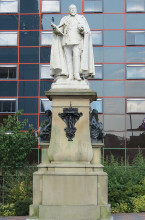 Edward VII, by Albert Toft.
Edward VII, by Albert Toft.
Birmingham’s statue of Edward VII was put up 1913, three years after his death, close to the Queen Victoria statue in the eponymous Victoria Square. But the combination of the white Carrara marble King with the bronze Queen was never that comfortable, and when the Square was revamped at the beginning of the 1950s, King Edward VII was banished to Highgate Park. This was a mistake – away from busy areas, the statue suffered vandalism, and theft of the bronze allegorical figures at the base. The story has a happy ending, because to coincide with the 100th anniversary of King Edward VII’s death, the statue was restored, and replacement subsidiary figures, presumably were made, described as replicas. The renovated memorial now stands close to by the Hall of Memory, in Birmingham’s Centenary Square.
The King stands, one foot slightly forward, uncrowned but wearing his coronation regalia, and holding orb and sceptre. Being in modern attire, even with the jewellery it would not look that grand, and the sculptor has made his coronation robe, a fur cloak, massive and enveloping, which broadens and adds majesty to the figure.
On the front of the pedestal on which the statue stands is a small figure of St George, pressing his long sword into the hapless dragon, a small beast with a griffinlike head, thus a beak rather than toothed mouth, and with protruding tongue as though it were in the act of making some exasperated hiss. St George is an Art Nouveau figure, with a certain languor of pose, and characteristic lines to his plate armour. He stands in a niche made by a sort of coronet above and cartouche around and behind, all curls and twists and 1900s styling. For other statues of St George and the Dragon, see this page.
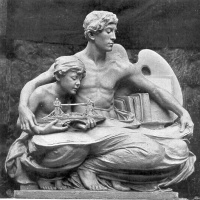
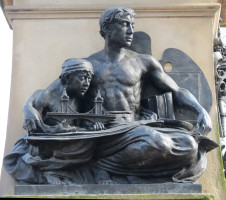 Progress fostered by Education, 100 years ago and now.
Progress fostered by Education, 100 years ago and now.
On the sides of the pedestal are the two replacement allegorical figures. On the left as we look at the group is a young athlete, crouched down, arms rather splayed, one around the shoulder of a child holding a model of Tower Bridge in London. Under the athlete’s other arm are books and a shallow pot, a sheaf of papers lies across his lap and the child’s, and behind him is large palette. The figure of the man, bare from the waist up, is a study of male musculature, above all the exposed arm and shoulder. The child – I think it is a boy – is Progress fostered by Education, the man. Is this a replica of the original? The composition is the same, and the figures are good, and the hands particularly so, but the faces do not quite have the look of the period, and are not characteristic of the sculptor, Albert Toft - click on the picture above right, and look at the boy's face to see this. More statues of Education may be seen on this page.
Peace, in 1912, 1913 (bronze), and modern version.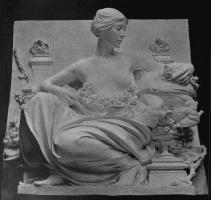
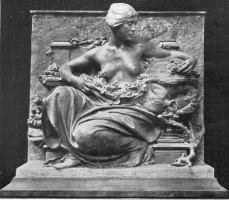
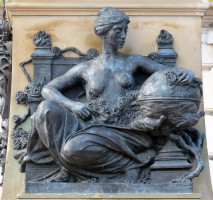
On the other side of the pedestal, so to our right as we look at the front of the monument, is the figure of Peace, as a semidraped girl. Here there is no question that this could be the work of Albert Toft – the face is modern (click to see), the neck too thin, and Albert Toft, always with an eye for his particular type of ideal female figure, would never have made breasts like these. There is always a bit of a change from stone or plaster to bronze, as we can see in the first two pictures above, and somewhat a loss of flesh, but the differences with the modern figure, above right, are striking. Nevertheless, the figure is good, the pose is as Toft had it, with garlands of roses, globe past which two doves are flying, and satisfying lines to the drapery which forms her long skirt. But by Toft she is not.
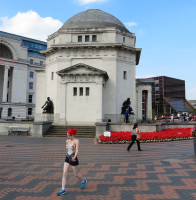 Birmingham's Hall of Memory, with passer by.
Birmingham's Hall of Memory, with passer by.
Close by in the Square is the Birmingham Hall of Memory, with four more bronze statues, and these are certainly by Albert Toft – an interesting comparison can be made.
The sculptor, Albert Toft, is one of the central figures of the New Sculptor movement working from late in the Victorian era through to after World War I. He was born in Birmingham – his father worked for Elkington – and has a variety of other public monuments across the country. Some more information on this page.
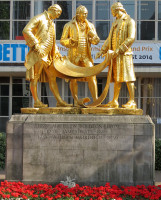 Statues of Boulton, Murdock and Watt.
Statues of Boulton, Murdock and Watt.
A couple of minutes walk away is the group of three statues, gilded, of Boulton, Murdock and Watt, by the sculptor William Bloye and dating from 1939.
This page was originally part of a 'sculpture of the month' series, for Nov. 2014. Although the older pages in that series have been absorbed within the site, if you would wish to follow the original monthly series, then jump to the next month (Dec. 2014) or the previous month (Oct. 2014). To continue, go to the bottom of each page where a paragraph like this one allows you to continue to follow the monthly links.
Birmingham pages // Sculpture in England // Sculpture pages
Visits to this page from 1 Nov 2014: 5,115 since 30 January 2021